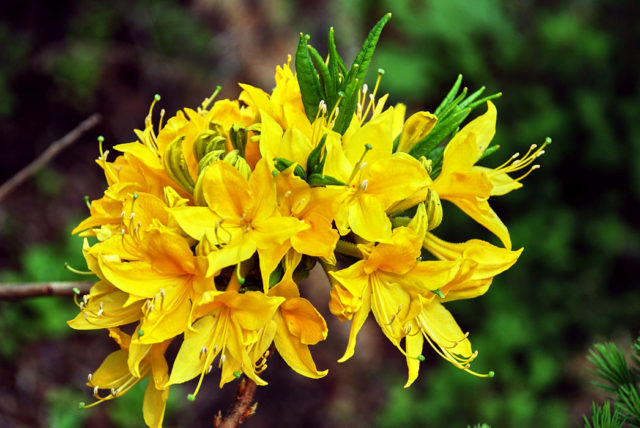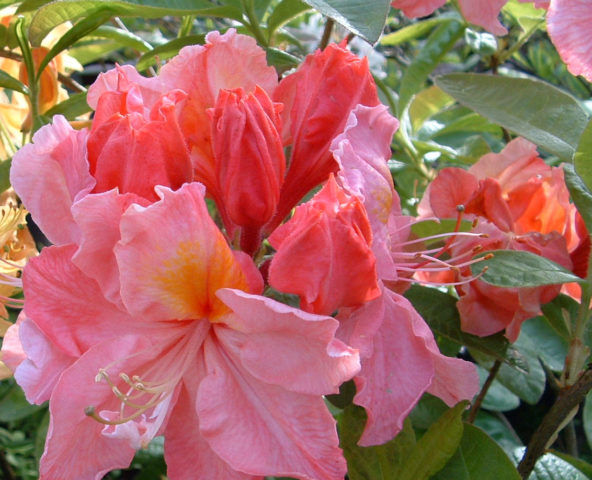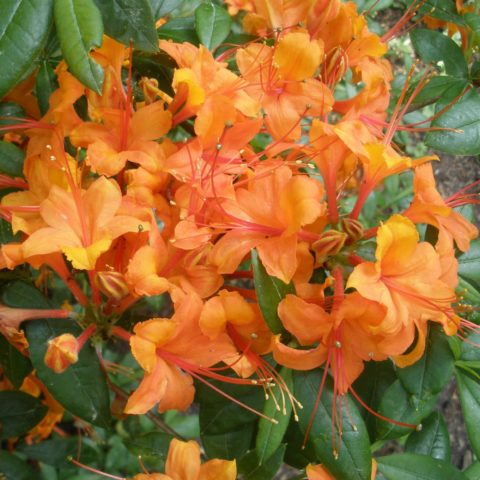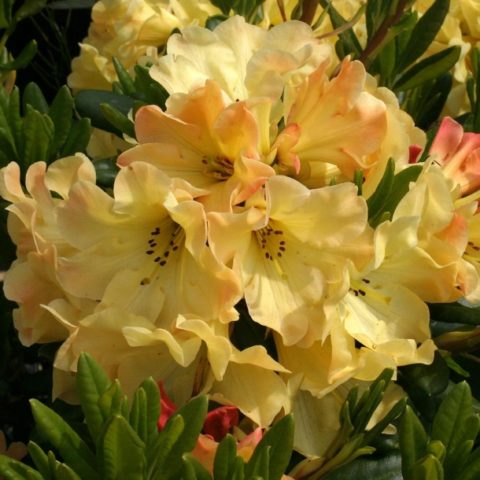Content
Rhododendron Pontus is a deciduous shrub that belongs to the Heather family. Today, this type of family has more than 1000 subspecies, including indoor rhododendrons. If we consider this name in translation from the Greek language, then it translates as "rose tree", "tree with roses." As practice shows, the flowers of this culture in appearance resemble a rose. Rhododendron buds can differ not only in shape and size, but also in color.
Description of Pontic rhododendron
Rhododendron Pontic (roseum) is often called "yellow stupor". This name was given because the flowers exude a strong enough scent. A distinctive feature of the culture is the rapid growth process, in addition, the Pontic rhododendron has a high level of resistance to many types of diseases and pests.
The leaf plate of the Pontic rhododendron is elongated, painted in a dark green tint, the edge of the leaf is ciliated. In the process of the appearance of young leaves, you can see that they are slightly pubescent, but over time, the fluff completely disappears.
During the flowering period, rather large flowers of a rich yellow hue appear, in some cases there may be buds of pink or lilac color. At the very bottom, the petals are fused, slightly bent, while they are collected in inflorescences of about 10-12 pcs.
The root system of the Pontic rhododendron is on the surface. After the flowering process is completed, fruits appear that in appearance resemble cylindrical bolls. These boxes contain seeds.
Varieties of Pontic rhododendron
When choosing a Pontic rhododendron for planting, you should understand that its distinctive feature is a bright color and a fairly strong aroma. In addition, do not forget about the fact that the leaf plate can change over time from saturated green to orange or red.
Rhododendron Pontic includes a large number of hybrid varieties. If we consider the most popular varieties, then it is worth paying attention to 3 types.
Cecile - a sprawling bush, on which pink flowers appear, the crown resembles a semicircle in shape.
Coccinea Speciosa - a rather lush bush with bright orange buds.
Nancy Vaterer - a rather large plant with large yellow flowers of an unusual shape (wavy petals with corrugated edges).
Each gardener has the opportunity to choose exactly the option that best suits the design of the site.
Planting and caring for Pontic rhododendron
In order for the Pontic rhododendron to please with its appearance and abundant flowering, you will need to pay due attention to the planting process and further care of the crop. In the process of growth, plants need irrigation, top dressing, preparation for wintering. It is important to understand that with improper care, there is a high probability that pests and diseases will appear.
Selection and preparation of the landing site
When choosing a place for planting the Pontic rhododendron, it is worth taking into account the fact that it is a light-loving plant, but at the same time it does not like when direct sunlight falls on it. That is why it is recommended to choose an area that has little shading and diffused light.
The ideal option would be to choose a site that is in close proximity to a body of water, for example, a pool, pond or river. If there are no reservoirs, then the Pontic rhododendron will need to be periodically sprayed with warm water until the flowering period begins.
Seedling preparation
Before planting the Pontic rhododendron on a permanent place of growth, it is required not only to choose the right site and prepare it, but also to prepare the seedlings themselves. In stores, you can find special rooters with which the root system is pretreated. This approach will contribute to the fact that the planting material will quickly take root in a new place and will grow.
Landing rules
It is necessary to plant the Pontic rhododendron in a hole, the depth of which is 40 cm, and the diameter is 60 cm.In order to prepare the soil, it is worth taking:
- peat - 8 buckets;
- loam - 3.5 buckets;
- clay - 2 buckets.
These components are mixed and poured into the bottom of the well. After the Pontic rhododendron is planted in a permanent place of growth, the soil is irrigated and mulched, using peat, oak foliage, pine needles or moss for these purposes. The mulch layer should be about 6 cm.
Watering and feeding
Rhododendron is very fond of moisture, not only in the soil, but also in the air. It is especially recommended to approach the irrigation system carefully during bud formation and during the flowering period. For irrigation, it is worth using soft water - rainwater or one that has been previously defended for several days. Adult shrubs are usually watered every 2-3 weeks, each bush should take up to 1.5 buckets of water. If necessary, you can apply mineral and complex fertilizers, which will allow you to get abundant flowering.
Pruning
Pruning of Pontic rhododendron should be minimal. This is due primarily to the fact that the bushes independently form a fairly beautiful crown. Pruning is resorted to only in cases where it becomes necessary to remove dry or frozen shoots during the winter period. Pruning is best done in the spring before the juices begin to move. After the shoots have been removed, the cut sites are treated with a garden varnish. A month later, the formation of dormant buds can be observed. Old bushes must be removed to a height of up to 40 cm.
Preparing for winter
Equally important is the preparation of the Pontic rhododendron for wintering. It is important to understand that in winter, during severe frosts, there is a high probability that the culture will die. That is why it is recommended to cover the bushes. Burlap is perfect as a shelter. Spruce or pine branches should be put between the shoots, and the bushes are pulled together with a rope. It is necessary to remove these shelters only after the snow melts.
Reproduction
If necessary, the Pontic rhododendron can be propagated. At the moment, there are several ways: cuttings and seeds.
The propagation method by cuttings is as follows:
- After the culture has faded, it is necessary to cut the cuttings up to 8 cm long.
- After that, the planting material is placed in a solution of potassium permanganate and immersed in the ground.
- After 60 days, the appearance of the first roots can be observed - at this time, the plant can be planted in open ground.
If you plan to use seeds for planting, then adhere to the following algorithm:
- In spring, the seeds are planted in a nutritious soil consisting of sand and peat.
- From above, the soil is irrigated and covered with a small layer of sand.
- After 4 weeks, the first shoots appear.
It is recommended to practice picking seedlings several times - in June and March.
Diseases and pests
As practice shows, most often the Pontic rhododendron is susceptible to the appearance of root rot, rust and leaf spot. In this case, it is recommended that you take appropriate corrective action in a timely manner. Fundazol, Bordeaux liquid, copper oxychloride are excellent for processing culture.
Of the pests of this variety, the spider mite and the rhododendron bug are terrible. As a preventive measure, many gardeners recommend treating with warm water. Pests appear only if the air is very dry.
Conclusion
Rhododendron Pontic is a variety that has an attractive appearance. A distinctive feature of this variety is the rich bright color of the buds and a strong aroma, which can rightfully be called intoxicating. If you provide the plants with proper care, they will decorate any area and will delight with their appearance.













